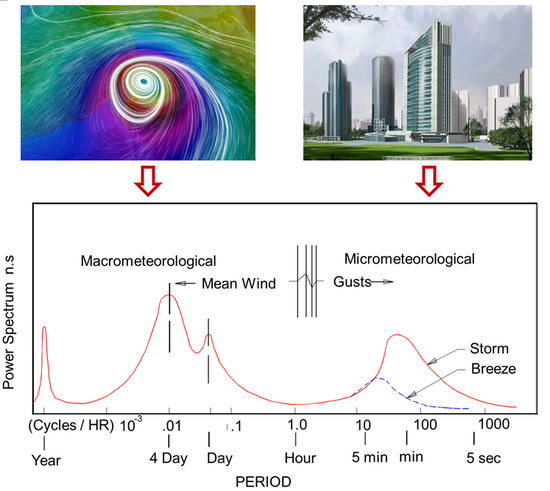Wind Characteristics Investigation on The Roofs of Three Adjacent High-Rise Buildings in a Coastal Area during Typhoon Meranti
Abstract
:1. Introduction
2. Field Measurements
3. Research Method for Wind Characteristics
4. Analysis of the Measured Fluctuating Wind Speed Data
4.1. Mean Wind Speed and Wind Direction
4.2. Turbulence Intensity
4.3. Gust Factor
4.4. Turbulence Integral Scale
5. Analysis of Fluctuating Parameters
5.1. Relations Between Fluctuating Parameters
5.2. Relations Between Fluctuating Parameters and Gust Duration
5.3. Wind Speed Spectrum
5.4. Relativity of Wind Turbulence
6. Conclusions
Author Contributions
Funding
Conflicts of Interest
References
- Cao, S.; Tamura, Y.; Kikuchi, N. Wind characteristics of a strong typhoon. J. Wind Eng. Ind. Aerodyn. 2009, 1, 11–21. [Google Scholar] [CrossRef]
- Quan, Y.; Yao, B.; Gu, M. Research Progress of Wind Reliability of High-rise Buildings. J. Tongji Univ. (Nat. Sci.) 2015, 6, 807–815. [Google Scholar] [CrossRef]
- Davenport, A.G. The spectrum of horizontal gustiness near the ground in high winds. Q. J. R. Meteorol. Soc. 1961, 87, 194–211. [Google Scholar] [CrossRef]
- Davenport, A.G. The relationship of reliability to wind loading. J. Wind Eng. Ind. Aerodyn. 1983, 13, 3–27. [Google Scholar] [CrossRef]
- Jackson, P.S. Wind structure near a city centre. Bound.-Layer Meteorol. 1978, 15, 323–340. [Google Scholar] [CrossRef]
- Lösslein, H. The structure of turbulence during strong winds. J. Wind Eng. Ind. Aerodyn. 1988, 28, 41–49. [Google Scholar] [CrossRef]
- Bowen, A.J. Full scale measurements of the atmospheric turbulence over two escarpments. Wind Eng. 1980, 1, 161–172. [Google Scholar] [CrossRef]
- Kato, N.; Ohkuma, T.; Kim, J.R.; Marukawa, H.; Niihori, Y. Full scale measurements of wind velocity in two urban areas using an ultrasonic anemometer. J. Wind Eng. Ind. Aerodyn. 1992, 41, 67–78. [Google Scholar] [CrossRef]
- Li, Q.S.; Xiao, Y.Q.; Wu, J.R.; Fu, J.Y.; Li, Z.N. Typhoon effects on super-tall buildings. J. Sound Vib. 2008, 3, 581–602. [Google Scholar] [CrossRef]
- Fu, J.Y.; Li, Q.S.; Wu, J.R.; Xiao, Y.Q.; Song, L.L. Field measurements of boundary layer wind characteristics and wind-induced responses of super-tall buildings. J. Wind Eng. Ind. Aerodyn. 2008, 96, 1332–1358. [Google Scholar] [CrossRef]
- Gu, M.; Kuang, J.; Wei, X.; Xiong, L.J.; Quan, Y. Field meansurement of strong wind speed of normal climate on top of Shanghai World Financial Center. J. Tongji Univ. (Nat. Sci.) 2011, 39, 1592–1597. [Google Scholar] [CrossRef]
- An, Y.; Quan, Y.; Gu, M. Turbulence characteristics analysis of typhoon “Muifa” near 500 m above ground in Lujiazui district of Shanghai. China Civ. Eng. J. 2013, 46, 21–27. [Google Scholar] [CrossRef]
- Mann, J.; Kristensen, L.; Courtney, M.S. The Great Belt Coherence Experiment: A Study of Atmospheric Turbulence Over Water; Riso National Laboratory for Sustainable Energy: Copenhagen, Denmark, 1991; pp. 51–60.
- Toriumi, R.; Katsuchi, H.; Furuya, N. A study on spatial correlation of natural wind. J. Wind Eng. Ind. Aerodyn. 2000, 2, 203–216. [Google Scholar] [CrossRef]
- Song, L.L.; Pang, J.B.; Jiang, C.L.; Huang, H.H.; Qin, P. Field measurement and analysis of turbulence coherence for typhoon Nuri at Macao Friendship Bridge. Sci. China Technol. Sci. 2010, 10, 2647–2657. [Google Scholar] [CrossRef]
- Xiang, H.F.; Ge, Y.J.; Zhu, L.D. Modern Theory and Practice on Bridge Wind Resistance, 1st ed.; China Communications Press: Beijing, China, 2005; pp. 82–105. [Google Scholar]
- Pang, J.B.; Ge, Y.J.; Lu, Y. Methods for Analysis of Turbulence Integral Length in Atmospheric Boundary-layer. J. Tongji Univ. (Nat. Sci.) 2002, 5, 622–626. [Google Scholar] [CrossRef]
- Glanville, M.J.; Kwok, K.C.S.; Denoon, R.O. Full-scale damping measurements of structures in Australia. J. Wind Eng. Ind. Aerodyn. 1996, 2–3, 349–364. [Google Scholar] [CrossRef]
- Khanduri, A.C.; Stathopoulos, T.; Bedard, C. Wind-induced interference effects on buildings-A review of the state-of-art. Eng. Struct. 1998, 7, 617–630. [Google Scholar] [CrossRef]
- Choi, E.C.C. Gradient height and velocity profile during typhoons. J. Wind Eng. Ind. Aerodyn. 1983, 13, 31–41. [Google Scholar] [CrossRef]
- Ishizaki, H. Wind profiles, turbulence intensities and gust factors for design in typhoon–prone regions. J. Wind Eng. Ind. Aerodyn. 1983, 13, 55–66. [Google Scholar] [CrossRef]
- He, X.; Qin, H.; Tao, T.; Liu, W.; Wang, H. Measurement of Non-Stationary Characteristics of a Landfall Typhoon at the Jiangyin Bridge Site. Sensors 2017, 17, 2186. [Google Scholar] [CrossRef]
- Gu, M.; Kuang, J.; Quan, Y.; Wei, X.; Xiong, L.J. Analysis of measured wind speed data on top of SWFC. J. Vib. Shock 2009, 28, 114–118. [Google Scholar] [CrossRef]
- Xu, A.; Fu, J.Y.; Zhao, R.H.; Wu, J.R. Field measurements of typhoon according to civil engineering research. Acta Aerodyn. Sin. 2010, 28, 23–31. [Google Scholar] [CrossRef]
- Li, Q.S.; Zhi, L.H.; Hu, F. Field Measurements of Strong Wind Characteristics Near Ground in Urban Area. J. Hunan Univ. (Nat. Sci.) 2009, 36, 8–12. [Google Scholar]
- Erich, H. Wind Turbines, Fundamentals, Technologies, Application. Economics, 3rd ed.; Springer: Heidelberg/Berlin, Germany, 2013; pp. 505–547. [Google Scholar]
- Durst, C.S. Wind speeds over short periods of time. Meteor. Mag. 1960, 89, 181–186. [Google Scholar]
- Krayer, W.R.; Marshall, R.D. Gust factors applied to hurricane winds. Bull. Am. Meteorol. Soc. 1992, 73, 613–618. [Google Scholar] [CrossRef]
- Yu, B.; Chowdhury, A.G. Gust factors and turbulence intensities for the tropical cyclone environment. J. Appl. Meteorol. Clim. 2009, 48, 534–552. [Google Scholar] [CrossRef]
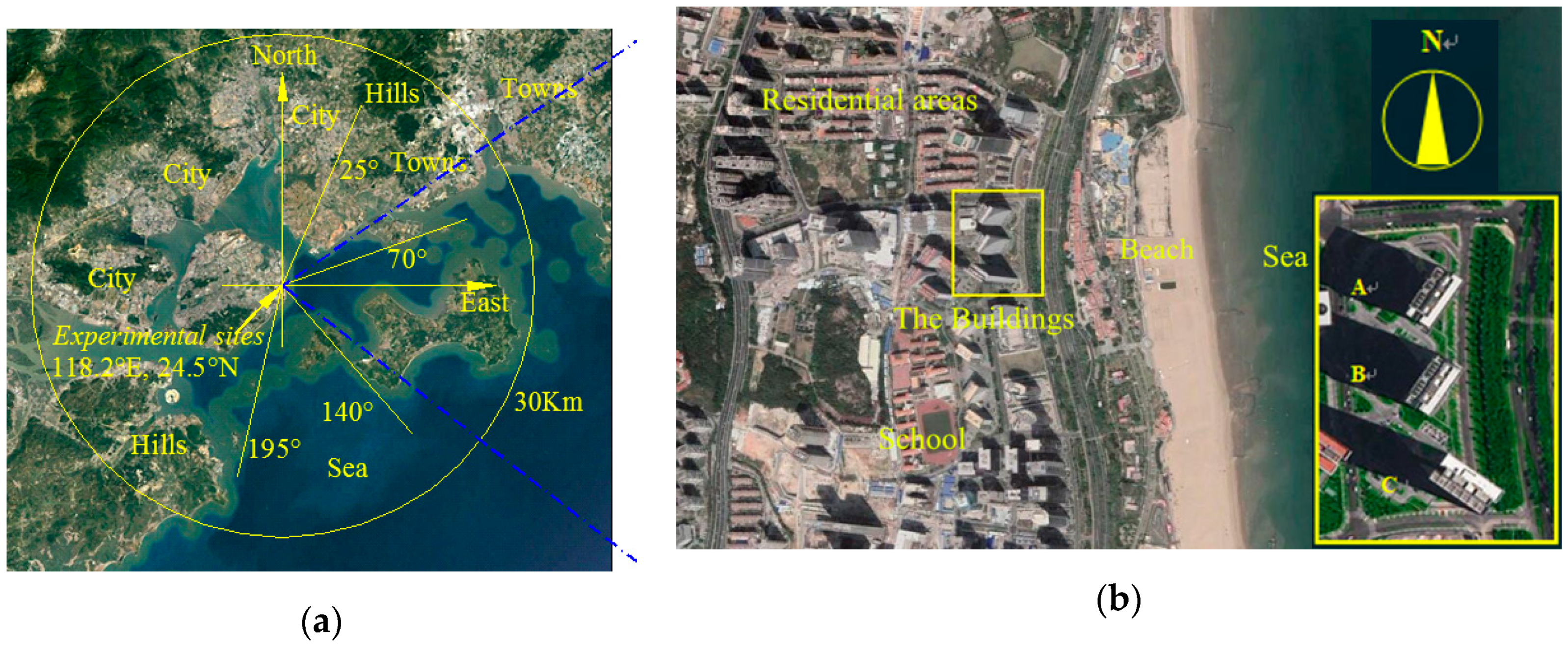
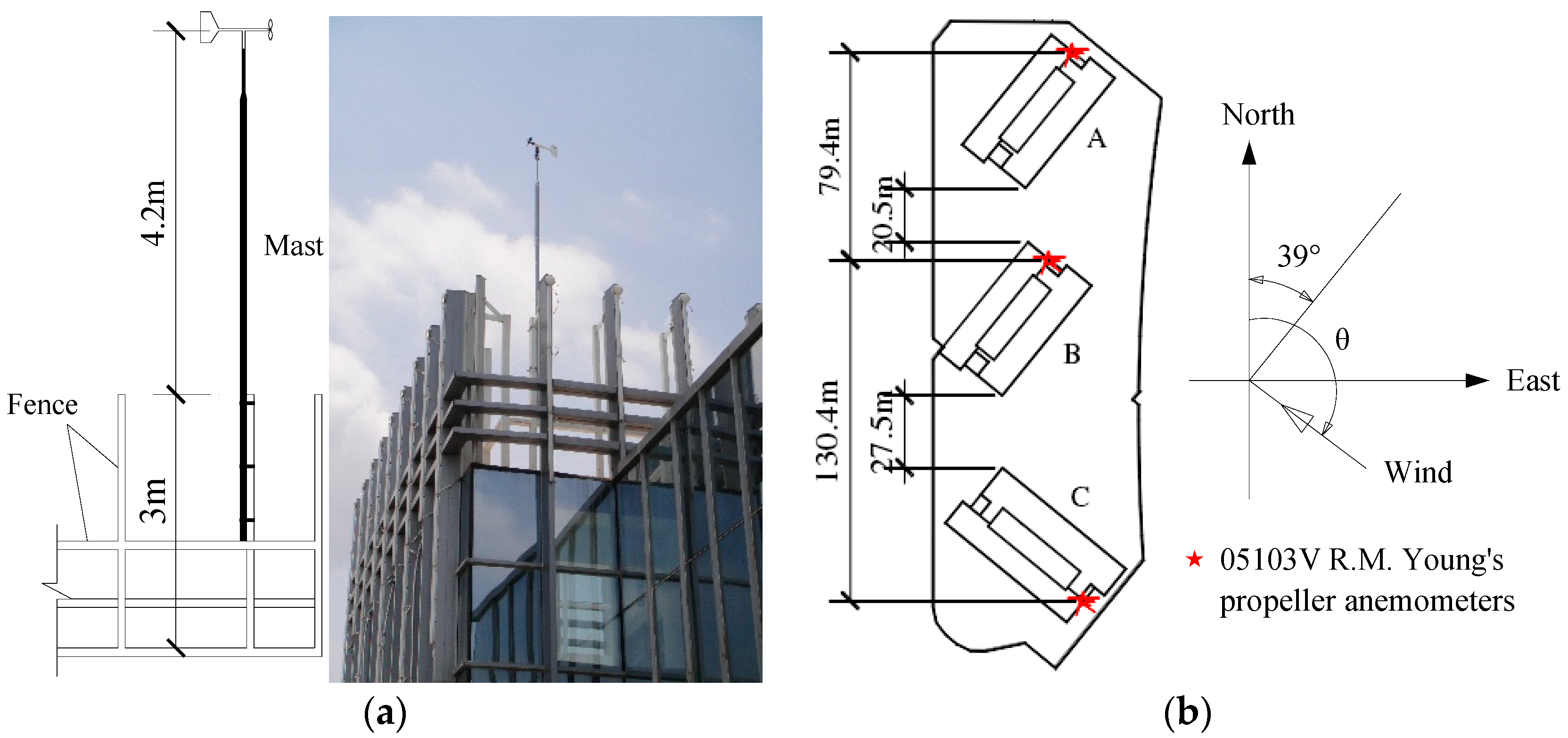
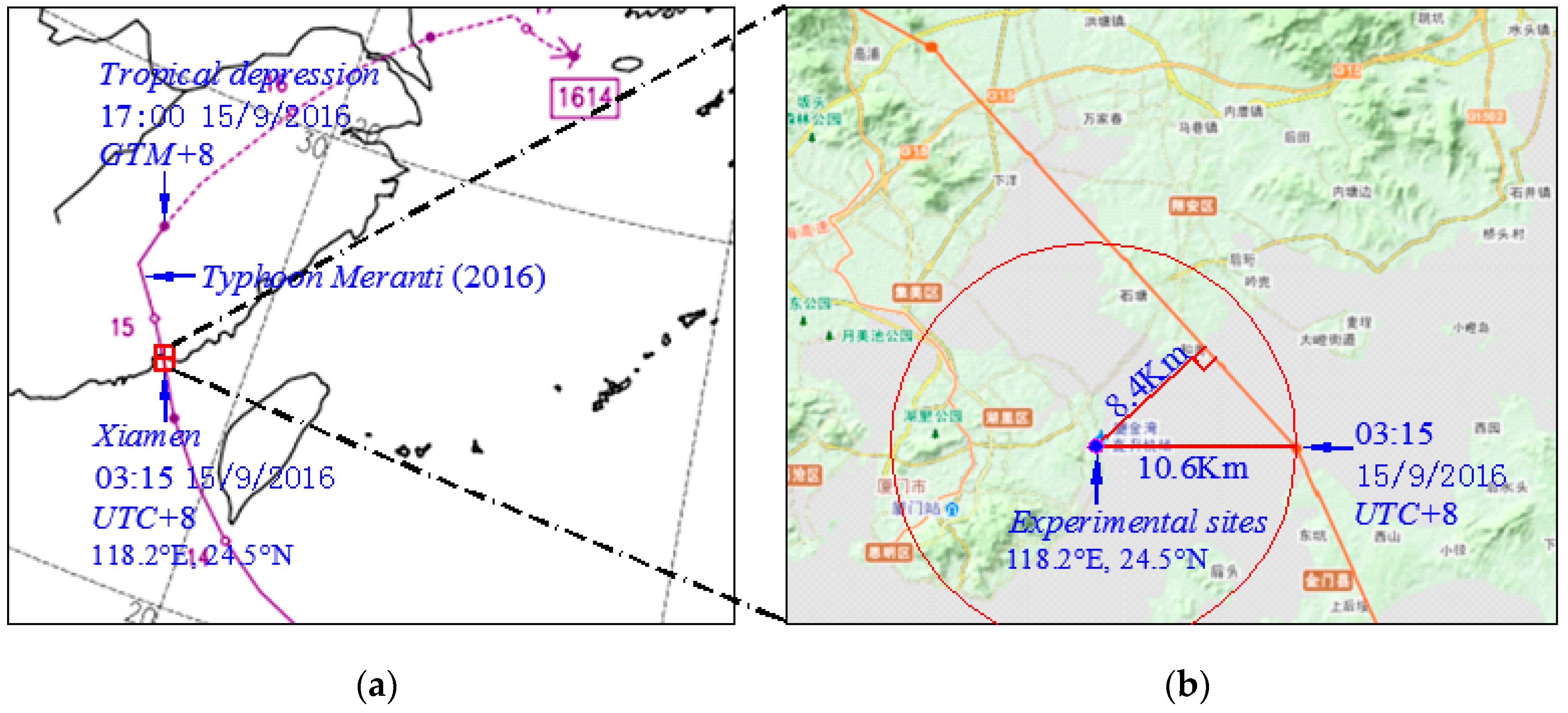
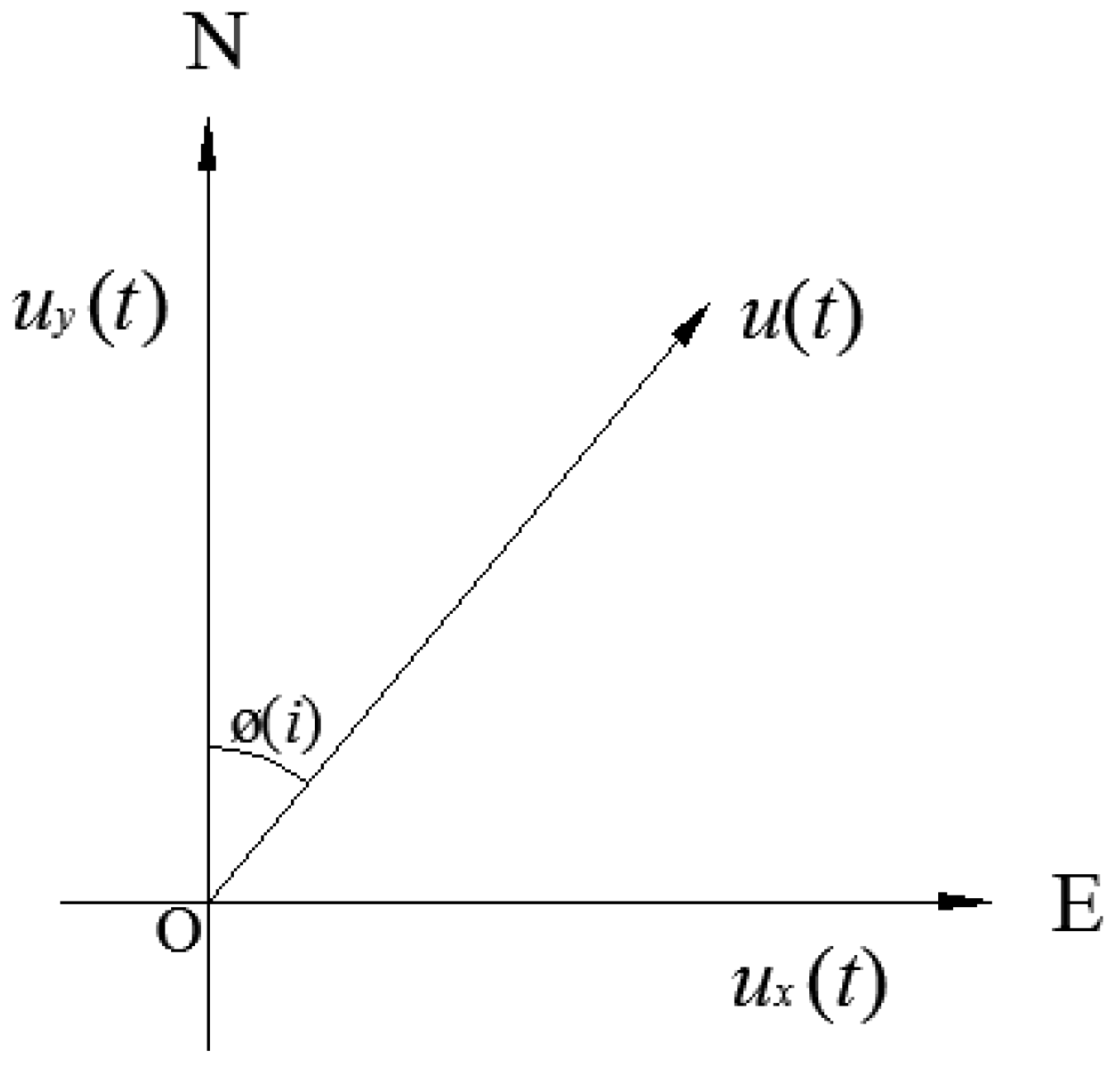
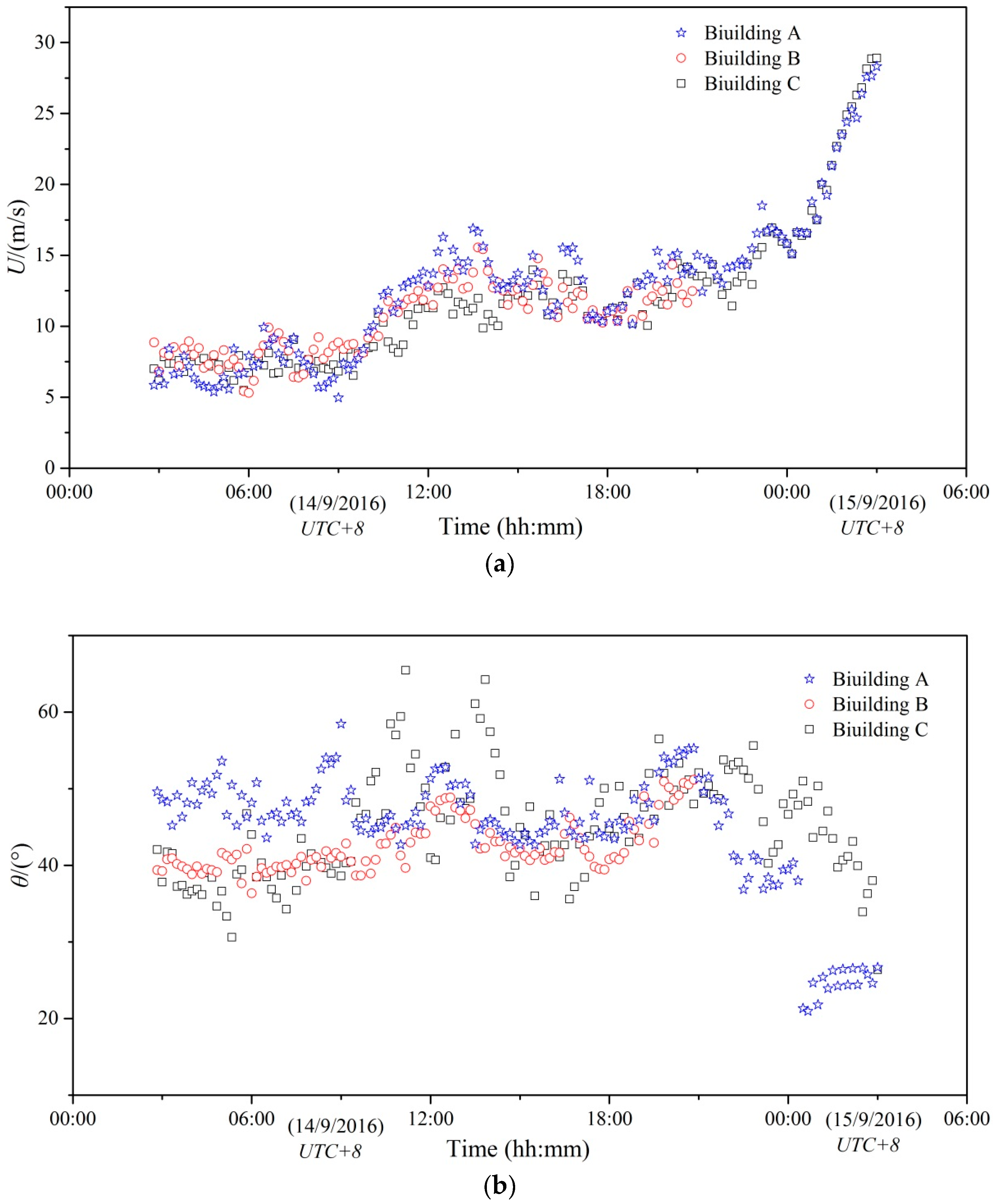
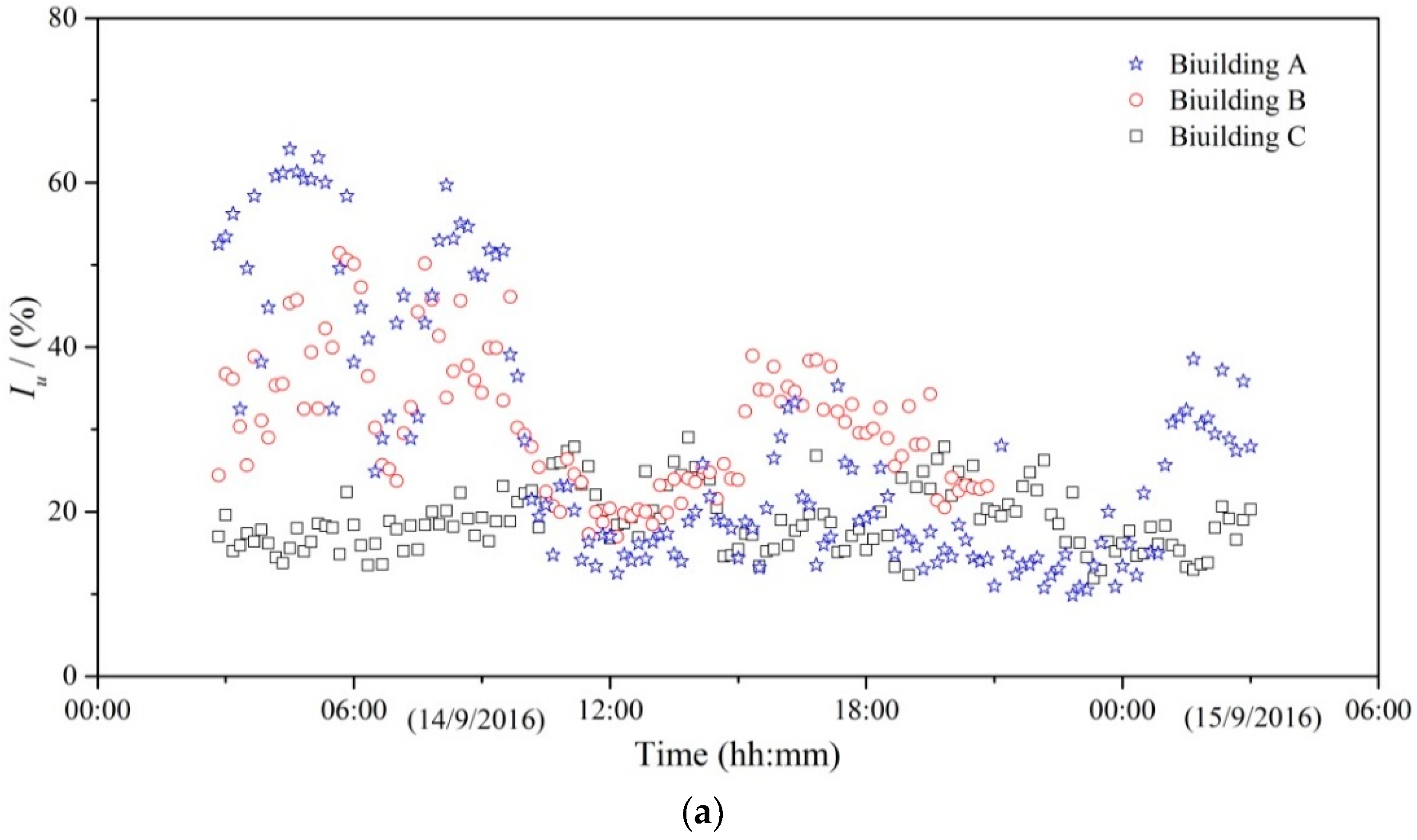

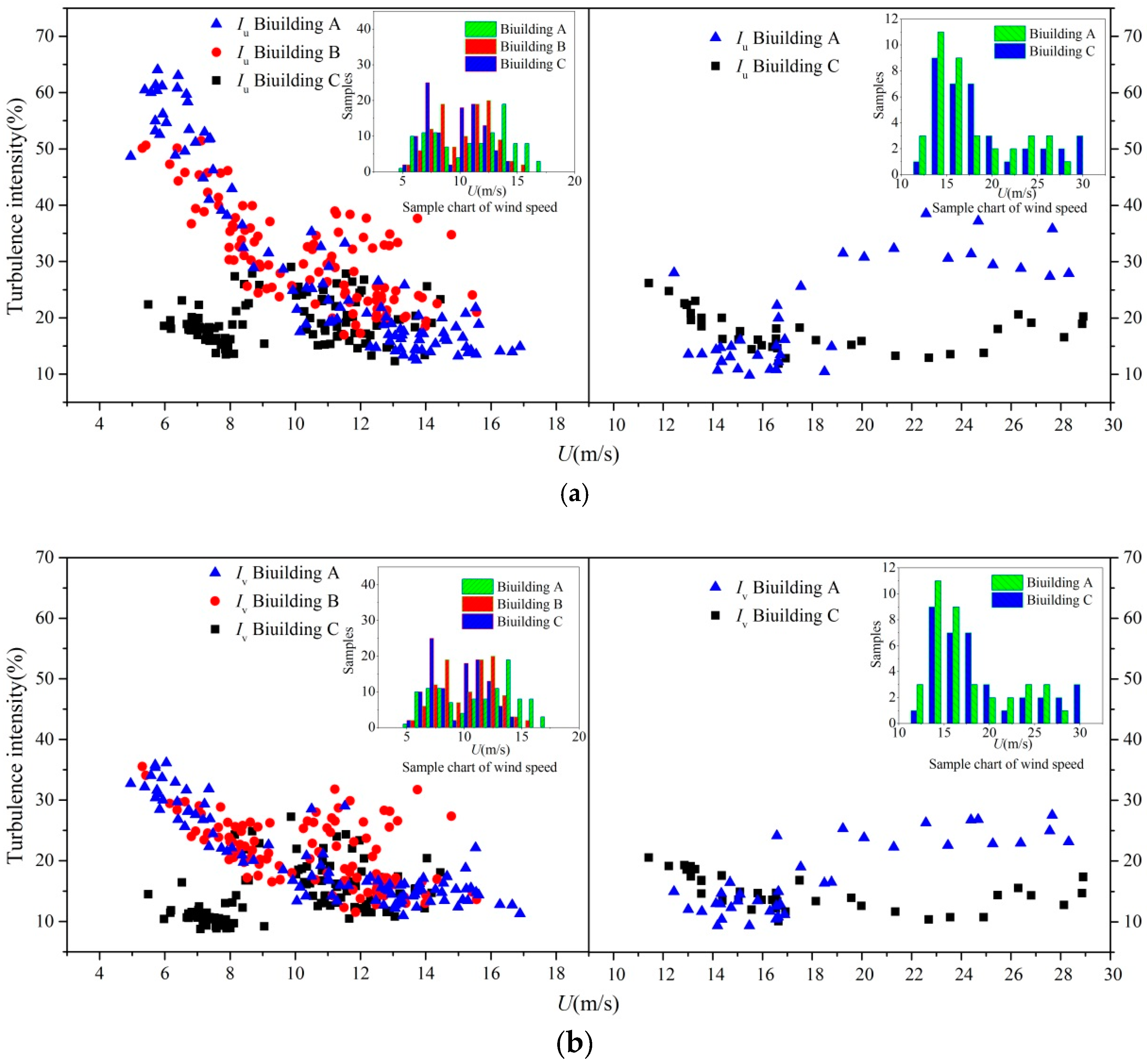
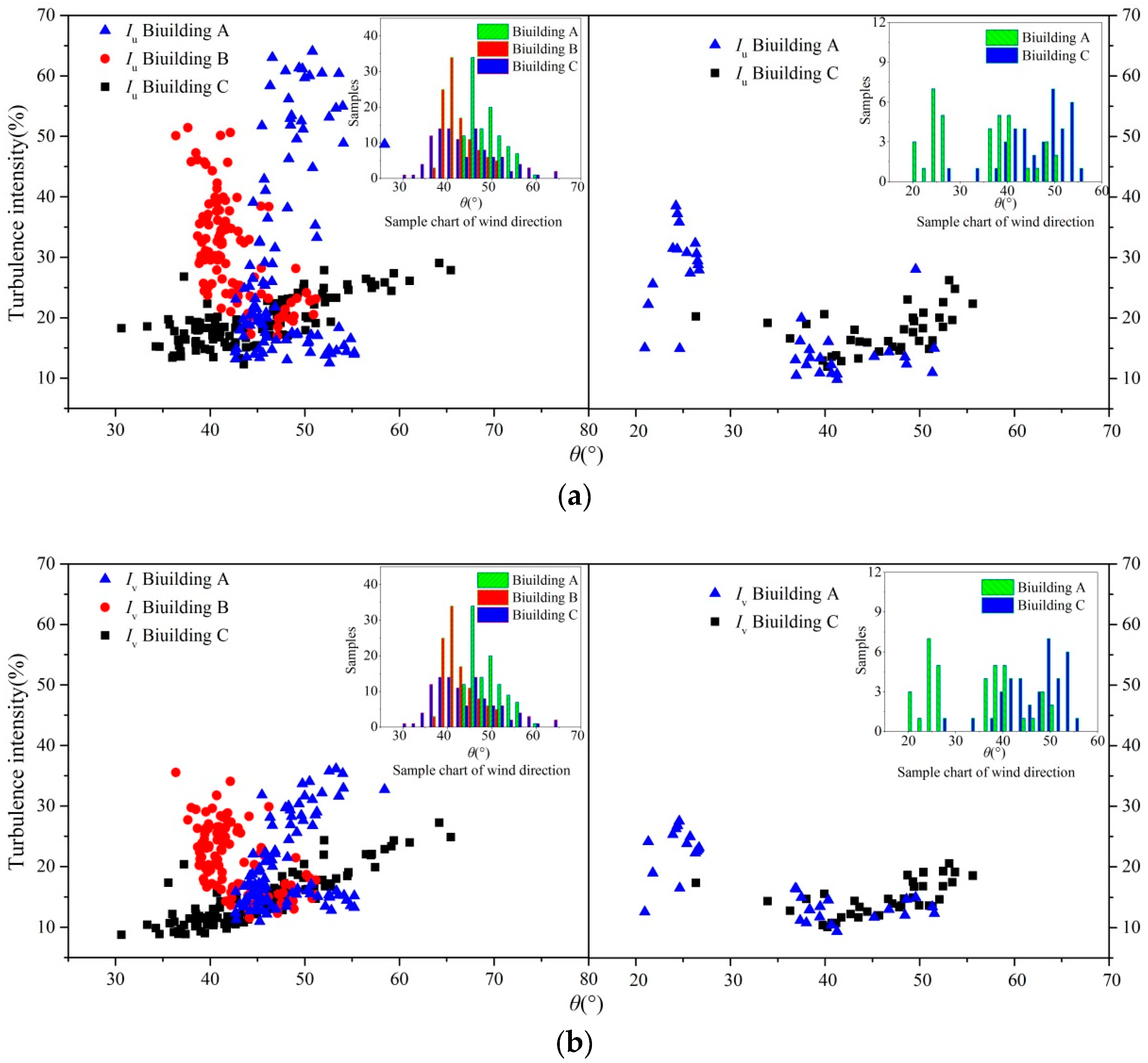
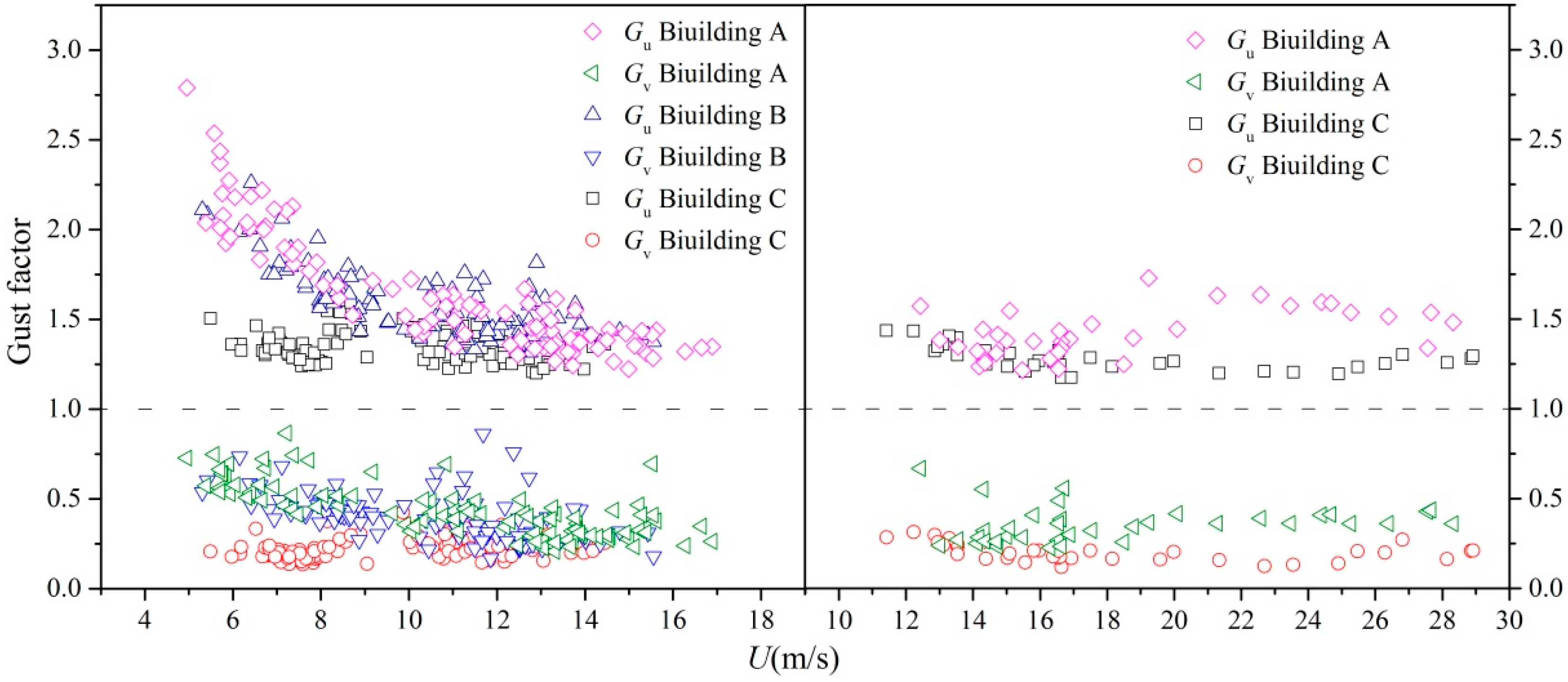
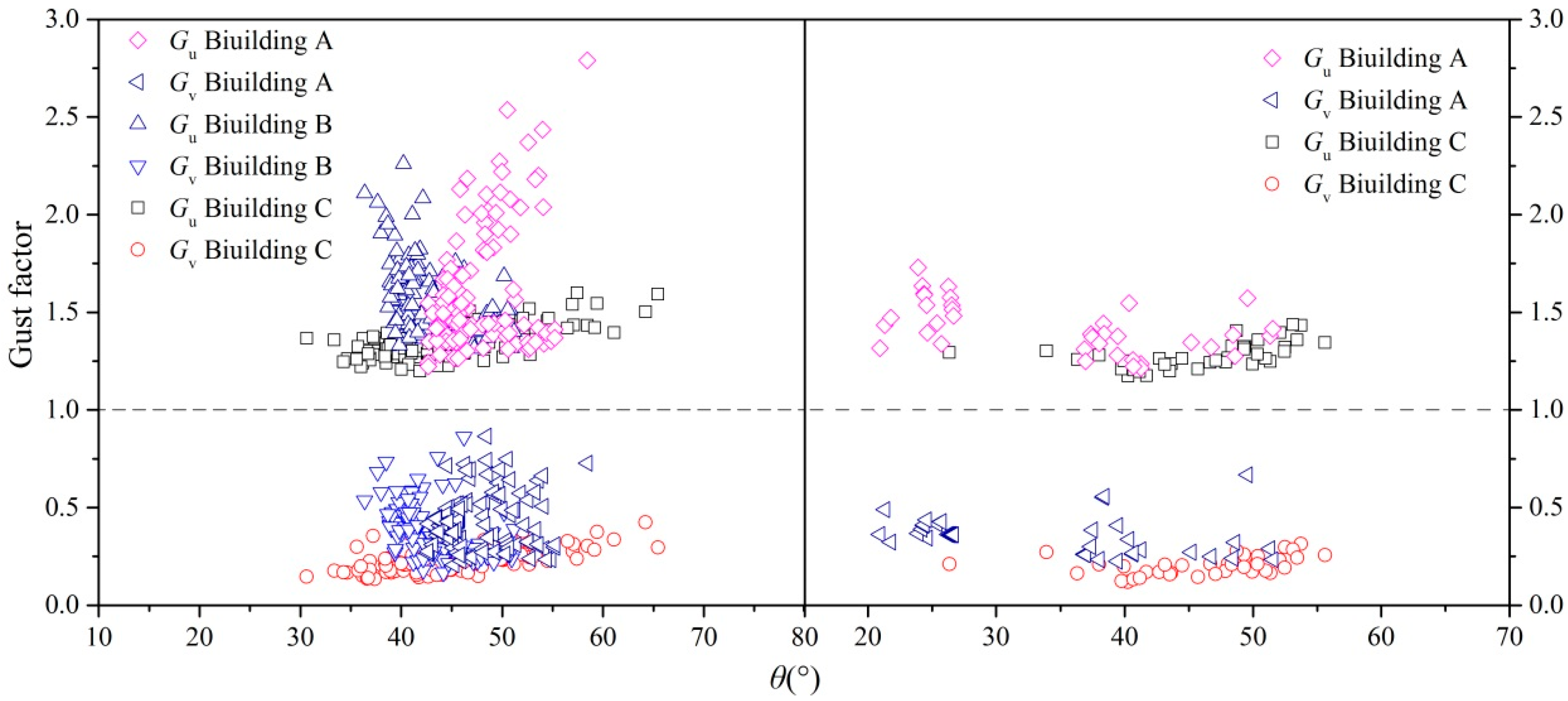
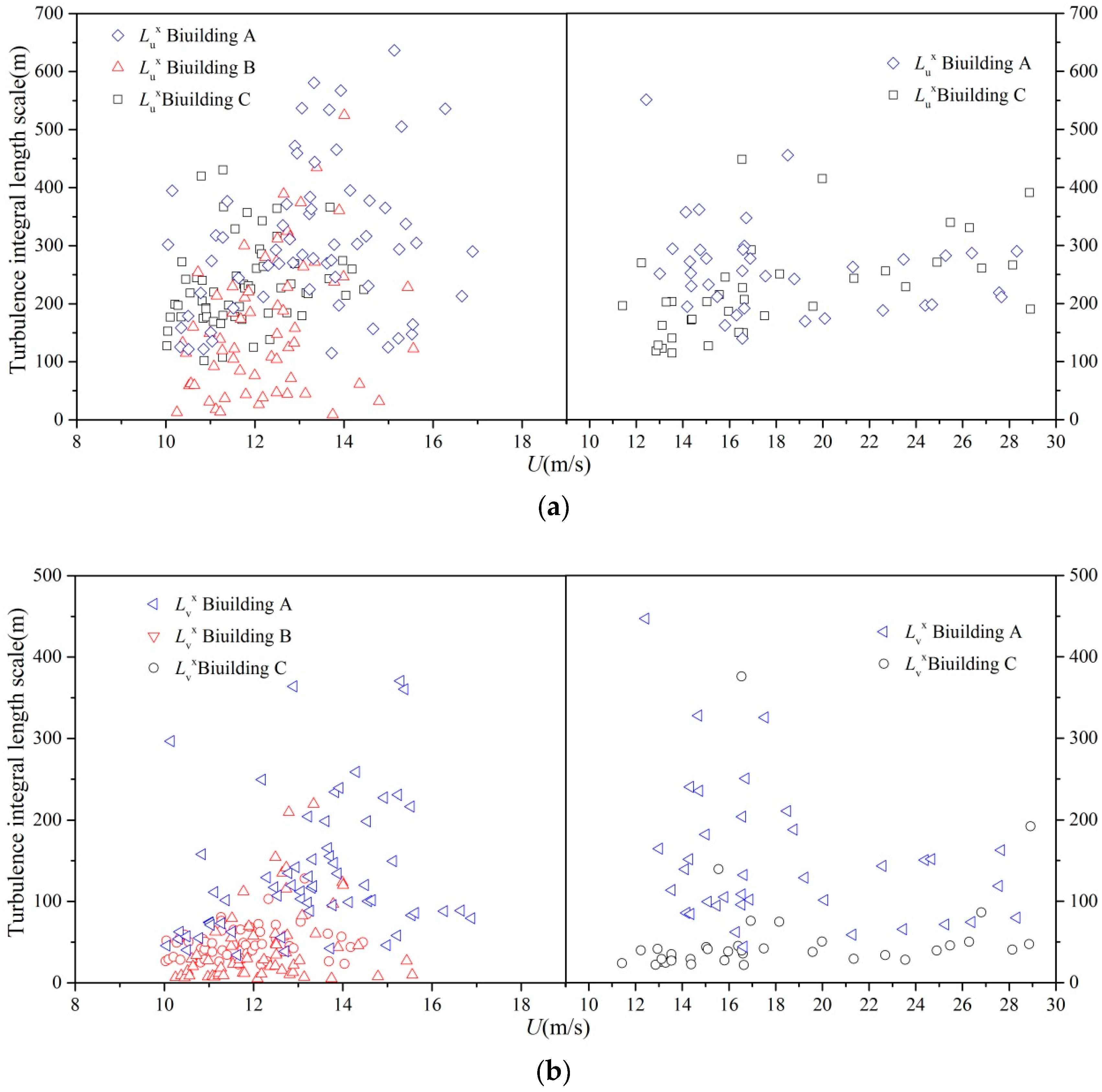

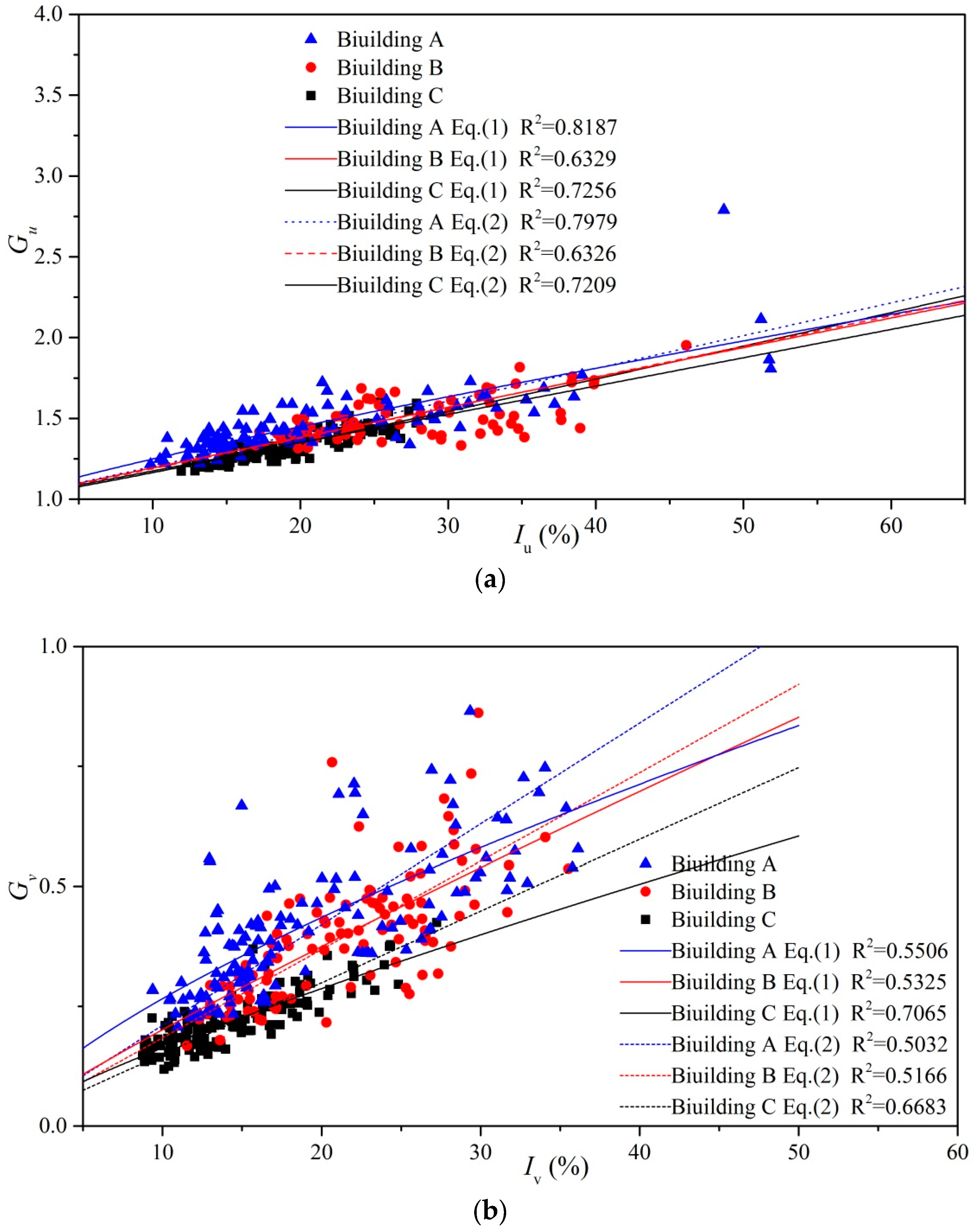
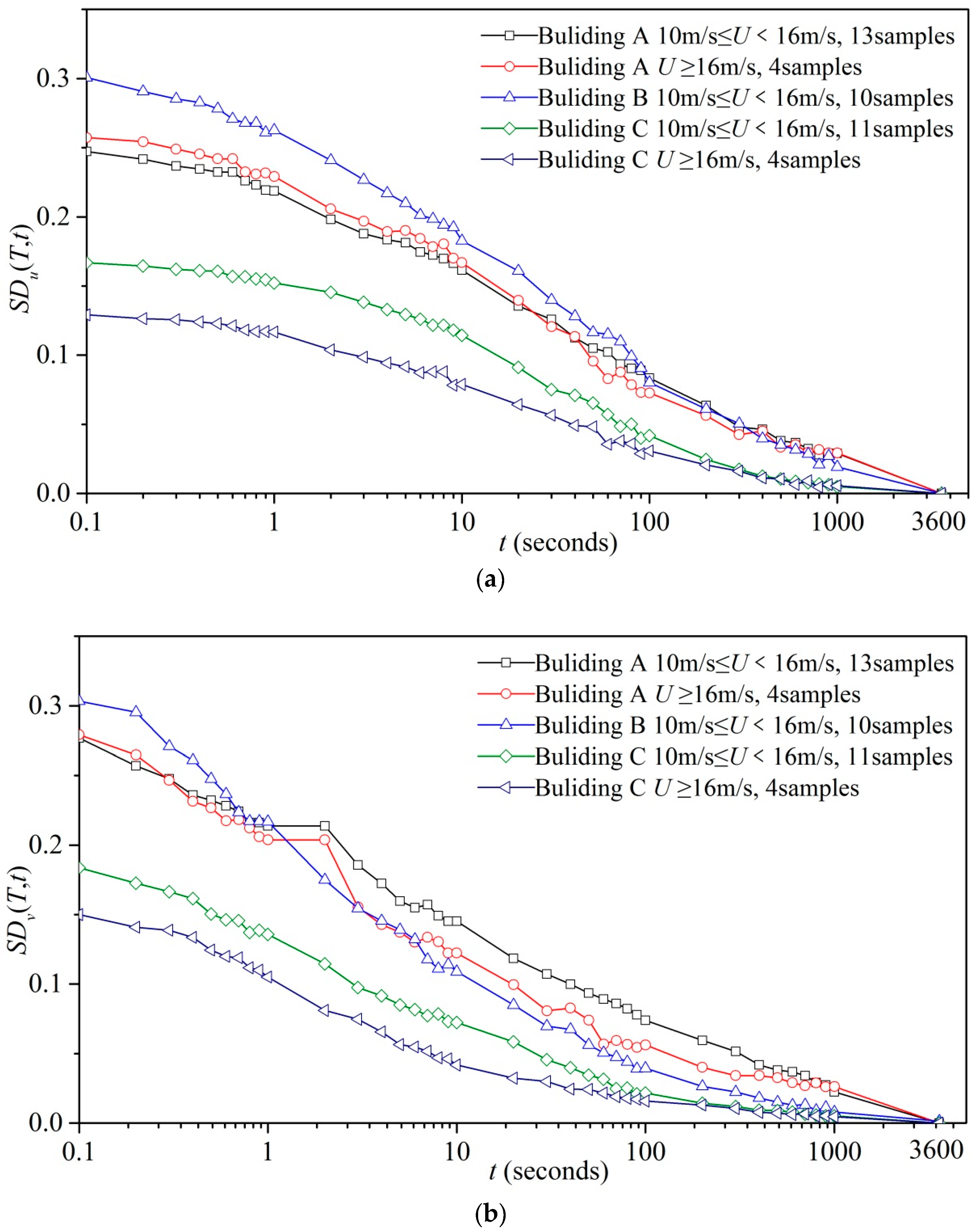


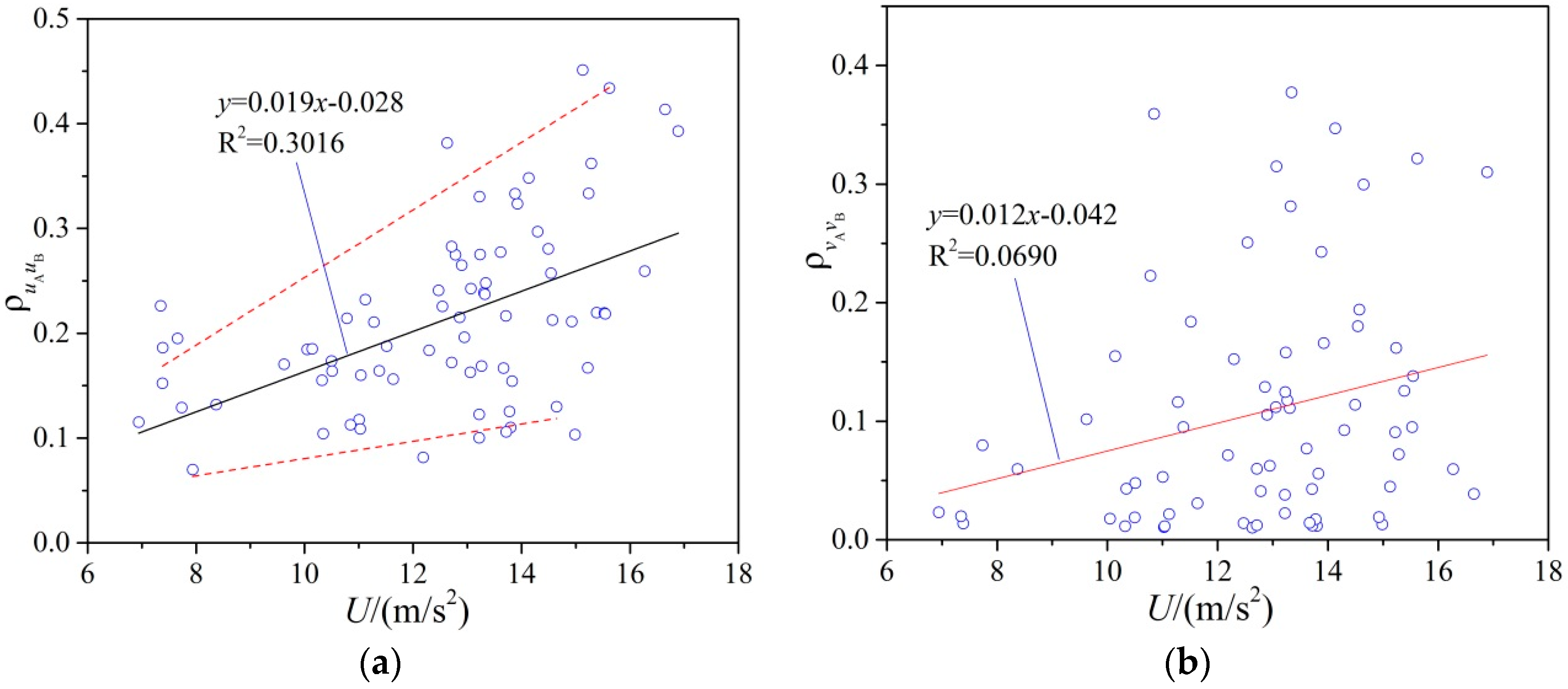
| Periods | Building | Samples | Mean Longitudinal Turbulence Intensity | Class D Terrain | Class C Terrain | Class B Terrain | Class A Terrain |
|---|---|---|---|---|---|---|---|
| Three sites | Building A | 109 | 30.4% | 17.3% | 12.6% | 9.3% | 8.6% |
| Building B | 109 | 30.8% | |||||
| Building C | 109 | 19.4% | |||||
| Two sites | Building A | 37 | 20.3% | ||||
| Building C | 37 | 17.7% |
| Periods | Building | Samples | Mean Longitudinal Gust Factor | Mean Lateral Gust Factor |
|---|---|---|---|---|
| Three sites | Building A | 65 | 1.64 | 0.44 |
| Building B | 63 | 1.59 | 0.40 | |
| Building C | 59 | 1.35 | 0.24 | |
| Two sites | Building A | 37 | 1.42 | 0.35 |
| Building C | 37 | 1.28 | 0.20 |
| Periods | Building | Samples | Mean Longitudinal Turbulence Integral Length Scales (m) | Mean Lateral Turbulence Integral Length Scales (m) |
|---|---|---|---|---|
| Three sites | Building A | 65 | 306 | 130 |
| Building B | 63 | 164 | 46 | |
| Building C | 59 | 231 | 49 | |
| Two sites | Building A | 37 | 260 | 149 |
| Building C | 37 | 224 | 55 |
| Building | Equation (1) | Equation (2) | ||
|---|---|---|---|---|
| longitudinal | A | k1 = 0.333 | k2 = 1.851 | ku = 0.382 |
| B | k1 = 0.349 | k2 = 1.978 | ku = 0.357 | |
| C | k1 = 0.380 | k2 = 2.087 | ku = 0.330 | |
| lateral | A | K3 = 0.258 | K4 = 1.711 | kv = 0.397 |
| B | K3 = 0.300 | K4 = 1.898 | kv = 0.348 | |
| C | K3 = 0.200 | K4 = 1.814 | kv = 0.282 | |
© 2019 by the authors. Licensee MDPI, Basel, Switzerland. This article is an open access article distributed under the terms and conditions of the Creative Commons Attribution (CC BY) license (http://creativecommons.org/licenses/by/4.0/).
Share and Cite
Wang, C.; Li, Z.; Luo, Q.; Hu, L.; Zhao, Z.; Hu, J.; Zhang, X. Wind Characteristics Investigation on The Roofs of Three Adjacent High-Rise Buildings in a Coastal Area during Typhoon Meranti. Appl. Sci. 2019, 9, 367. https://doi.org/10.3390/app9030367
Wang C, Li Z, Luo Q, Hu L, Zhao Z, Hu J, Zhang X. Wind Characteristics Investigation on The Roofs of Three Adjacent High-Rise Buildings in a Coastal Area during Typhoon Meranti. Applied Sciences. 2019; 9(3):367. https://doi.org/10.3390/app9030367
Chicago/Turabian StyleWang, Chequan, Zhengnong Li, Qizhi Luo, Lan Hu, Zhefei Zhao, Jiaxing Hu, and Xuewen Zhang. 2019. "Wind Characteristics Investigation on The Roofs of Three Adjacent High-Rise Buildings in a Coastal Area during Typhoon Meranti" Applied Sciences 9, no. 3: 367. https://doi.org/10.3390/app9030367
APA StyleWang, C., Li, Z., Luo, Q., Hu, L., Zhao, Z., Hu, J., & Zhang, X. (2019). Wind Characteristics Investigation on The Roofs of Three Adjacent High-Rise Buildings in a Coastal Area during Typhoon Meranti. Applied Sciences, 9(3), 367. https://doi.org/10.3390/app9030367




